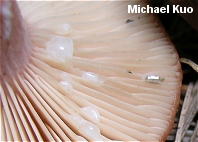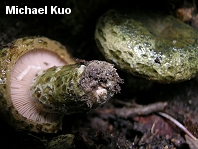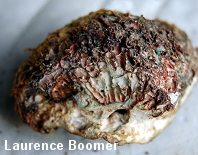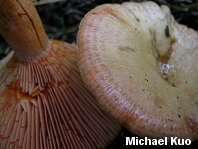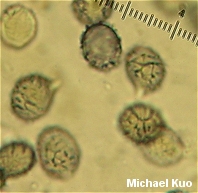(Incomplete) Key to 75+ North American Milky Caps

BYPASS LINKS:
sequestrates
Deliciosi
sordidus group
yellowing latex
purple staining
NOTE: This key is incomplete; it is a work in progress. It currently treats some of the trufflelike and "malformed" species (formerly and in some cases currently known as species of Arcangeliella and Zelleromyces); the species with colored milk (section Deliciosi); the small group of funky species centered around Lactarius sordidus; and those species possessing milk that turns yellow on exposure to air, or stains surfaces purple (not natural groups of related species, but handy groupings for identification). Many North American species not belonging to these groups remain untreated. An extensive references list follows the key.
| 1. | Mushroom sequestrate (either truffle-like and growing partially to completely underground, or more or less mushroomlike but with gills poorly formed). | 2 |
| 1. | Mushroom "normal" and not sequestrate. | 15 |
| 2. | Mushroom trufflelike; without a stem. | 3 |
| 2. | Mushroom with some kind of a stem structure (possibly as a columella— a fleshy stem-ish thing inside the mushroom that can be revealed by slicing the mushroom in half) but with poorly formed gills, or with a permanently closed up blob of a cap. | 10 |
| 3. | Found east of the Rocky Mountains, especially in the southeastern states. | 4 |
| 3. | Found from the Rocky Mountains westward. | 6 |
| 4. | Found under spruces; surface yellow to brownish yellow; spores with very high ornamentation extending up to 4 µm, amyloid in young specimens but with maturity yellowish to dextrinoid in Melzer's. | Zelleromyces sculptisporus |
| 4. | Found under oaks or spruce; spores with ornamentation 1–3 µm high, amyloid throughout development. | 5 |
| 5. | Found under pines; without a stem-like base; spores 11–18 µm long (excluding ornamentation). | |
| 5. | Found under oaks; young specimens with a nearly stem-like base that gets swallowed up with development; spores 8–9 µm long excluding ornamentation. | Zelleromyces versicaulis |
| 6. | Found under conifers; ornamentation strongly to partially amyloid, or inamyloid. | 7 |
| 7. | Outer surface reddish brown to brown, discoloring and staining green; interior staining red when sliced. | |
| 7. | Outer surface variously colored but not discoloring green; interior not staining red. | 8 |
| 8. | Found under limber pine in the southwestern states; spore ornamentation strongly amyloid. | Zelleromyces rogersonii |
| 8. | Found under various conifers on the West Coast; ornamentation partially amyloid, or nearly inamyloid. | 9 |
| 9. | Surface "cinnamon buff"; spines on spores completely amyloid or amyloid for the upper two-thirds. | Zelleromyces oregonensis |
| 9. | Surface yellowish to yellowish brown becoming mottled with reddish brown; spines on spores inamyloid or amyloid only at the tips. | Zelleromyces scissilis |
| 10. | Surface brownish; milk staining tissues brown to reddish. | |
| 10. | Surface variously colored; milk not staining tissues. | 11 |
| 11. | Surface pinkish to orangish or pinkish brown. | 12 |
| 11. | Surface whitish, yellowish, or dull olive. | 13 |
| 12. | Mushroom usually under 1 cm across. | Arcangeliella saylori |
| 12. | Mushroom 2.5–8 cm across. | Arcangeliella crassa |
| 13. | Mushroom usually under 2.5 cm across; surface whitish to yellowish. | Arcangeliella parva |
| 13. | Mushroom 2.5–8 cm across; surface yellowish or dull olive. | 14 |
| 14. | Cap 2–3 cm across; surface pale yellowish; spores ellipsoid. | Arcangeliella lactarioides |
| 14. | Cap 4–8 cm across; surface dull olive with yellow spots; spores globose to subglobose. | Arcangeliella variegata |
| 15. | Cap color varying from yellowish to orangish or bluish (especially when young), discoloring green and becoming often sordid green overall at maturity; milk scant, yellowish to brownish (but not orange); gills yellowish before discoloring greenish; spores 7–9 x 5–7 µm, with scattered connecting lines forming partial reticula; found under pines in eastern North America. | |
| 15. | Not completely as above. | 16 |
| 16. | Milk colored as exuded (slice young specimens and check the flesh in the stem apex and near the gills); dark green stains often developing on surfaces. | 17 |
| 16. | Milk watery, white or whitish as exuded—sometimes becoming yellow or yellowish after exposure to air; dark green stains rarely developing on surfaces (though cap and stem may be innately colored green, or milk may dry olive to pastel green). | 28 |
| 17. | Fresh cap whitish or buff (aside from staining). | 18 |
| 17. | Fresh cap more highly colored. | 20 |
| 18. | Gills bright salmon orange before staining; distributed in the southeastern United States and in Mexico. | Lactarius salmoneus |
| 18. | Gills yellowish to orangish before staining. | 19 |
| 19. | Western in distribution; growing under pines; milk red; stem without potholes. | Lactarius barrowsii |
| 19. | Known from Florida; growing under pines or oaks; milk orange; stem with potholes (cap whitish when young; later often yellowish to pinkish before staining). | Lactarius pseudodeliciosus |
| 20. | Associated with northern white-cedar in northeastern North America; cap orange; green staining and bruising absent throughout development. | |
| 20. | Range and mycorrhizal associations various; cap colors various; green stains developing, at least by maturity. | 21 |
| 22. | Fresh cap pinkish to purplish pink; milk red to purple-red. | 23 |
| 22. | Not completely as above. | 24 |
| 23. | Associated primarily with eastern hemlock in northeastern and eastern North America; spores 8–11 µm long. | |
| 23. | Associated with pines (species of Pinus); known from the Veracruz region of Mexico; spores 7–8 µm long. | Lactarius miniatosporus |
| 25. | Western in distribution; associated with pines (species of Pinus) or with Douglas-fir; gills orange or orangish before discoloring; cap brownish orange. | |
| 25. | Southern and eastern in distribution; associated with pines or with oaks; gills pinkish before discoloring; cap bluish to greenish or grayish, usually with a silvery sheen. | |
| 26. | Known from Florida under pines and oaks; cap pale, becoming yellowish; spores 7–9 µm long. | Lactarius pseudodeliciosus |
| 26. | Not as above; cap more or less orange, spores slightly or substantially longer than above, range and mycorrhizal associations various. | 27 |
| 27. | Known from California in association with spruce; cap small (2–5.5 cm across); green staining extensive; basidia, basidioles, and cystidia with dark contents. | Lactarius aurantiosordidus |
| 27. | Range and mycorrhizal association various; cap generally larger than above when mature; green staining slight or extensive; hymenial elements lacking dark contents. | |
| 28. | Cap dark green, olive, brown, or olive brown; cap surface magenta with KOH; stem with potholes. | 29 |
| 28. | Not completely as above. | 31 |
| 29. | Found in eastern North America in association with hardwoods (especially oaks); cap green; fresh gills pinkish. | |
| 30. | Western in distribution; cap olive; spores 7–10 x 6–9 µm, with ornamentation over .5 µm high. | Lactarius olivaceo-umbrinus |
| 30. | Widely distributed; cap yellow brown to brown, with olive hues; spores 5.5–7.5 x 5.5–6.5 µm, with ornamentation generally shorter than above. | Lactarius sordidus |
| 31. | Milk white or creamy as exuded but changing quickly (within 30 seconds) to yellow (the milk itself changing color, independently of color changes, including yellowing, in tissues; if uncertain, try isolating the milk on white paper). | 32 |
| 31. | Milk watery, white, or creamy as exuded, not changing quickly to yellow (but possibly becoming slightly and/or slowly yellowish, or changing to another color). | 64 |
| 32. | Fresh, young cap white, whitish, pale olive, or nearly so—sometimes developing pinkish or yellowish hues, sometimes with brownish to brown fibrils. | 33 |
| 32. | Fresh, young cap more highly colored. | 40 |
| 33. | Associated with birch (possibly also with aspen) or northern/montane conifers; young cap margin often bearded or hairy. | 34 |
| 33. | Associated with oaks (possibly with other hardwoods) in eastern, oak-based forests; young cap margin not bearded or hairy. | 37 |
| 34. | Cap pinkish orange, or with pinkish to orangish (occasionally yellowish) hues. | 35 |
| 34. | Pinkish to orangish hues absent from cap. | 36 |
| 35. | Spores 8–11 x 6.5–8 µm. | Lactarius torminosus
var. nordamensis |
| 35. | Spores 6.5–8 x 5.5–6.5 µm. | |
| 36. | Stem without potholes or with a few vague spots at maturity; pleurocystidia not projecting substantially beyond basidia. | |
| 36. | Stem with prominent potholes; pleurocystidia projecting. | |
| 37. | Stem without potholes. | 38 |
| 38. | Cap and stem with a downy, sub-velvety feel; gills bruising and discoloring cinnamon to brownish. | |
| 38. | Neither cap nor stem downy or sub-velvety; gills discoloring or not. | 39 |
| 39. | Milk changing from white to pale yellow; gills crowded, staining yellowish brown; spore print white. | Lactarius neuhoffii |
| 39. | Milk changing from white to darker yellow; gills close, not staining or spotting; spore print yellowish. | |
| 40. | Not associated with coast live oak; variously distributed. | 42 |
| 41. | Stem always without potholes; milk usually turning dark yellow with time; taste slowly slightly acrid. | |
| 41. | Stem usually with potholes; milk turning pale yellow or merely yellowish; taste quickly very acrid. | |
| 42. | Cap pink; young margin bearded; associated with birch. | 35 (above) |
| 42. | Cap not pink; young margin smooth to minutely hairy but not bearded; mycorrhizal associations various. | 43 |
| 43. | Stem without potholes. | 47 |
| 44. | Cap dark reddish brown. | Lactarius hysginus
var. subroseus |
| 44. | Cap yellow to orange. | 45 |
| 45. | Associated with conifers; distribution uncertain but possibly limited to western North America. | |
| 45. | Associated with hardwoods; distributed east of the Rocky Mountains. | 46 |
| 46. | Cap yellow to yellowish, often with a pinkish center. | Lactarius delicatus |
| 47. | Cap otherwise colored. | 52 |
| 48. | Mature cap small (under 4 cm across), pale tan to yellowish. | Lactarius subvernalis |
| 48. | Mature cap small or medium-sized; darker than above. | 49 |
| 4498. | Fresh cap dark red-brown to red or dark brown, turning olive with KOH; stem colored like the cap; associated with conifers. | |
| 49. | Not completely as above. | 50 |
| 50. | Mature cap small (under 4 cm across); taste mild; associated with cedar and alder in western North America. | Lactarius occidentalis |
| 50. | Mature cap larger than above; taste variable; associated with hardwoods in eastern North America. | 51 |
| 51. | Stem fragile, soon becoming hollow, darkening with age from the base up; young cap sometimes with faint zones. | |
| 51. | Stem sturdy, solid, not darkening; cap never zoned. | |
| 52. | Gills yellow, distant and thick; cap small (usually under 4 cm across), yellowish olive; apparently southern in distribution. | Lactarius xanthydrorheus |
| 52. | Not completely as above. | 53 |
| 53. | Cap otherwise colored. | 57 |
| 54. | Found in in California and the Pacific Northwest; cap scarlet orange to brownish orange, faintly and widely lined on the margin. | |
| 54. | Not completely as above. | 55 |
| 55. | Associated with birch; fresh cap dull orange to rusty orange, 3–8 cm across. | Lactarius theiogalus |
| 55. | Mycorrhizal associations various; fresh cap bright orange, variously sized. | 56 |
| 56. | Mature cap 5–10 cm across; found in dry hardwood forests east of the Rocky Mountains; flesh turning yellow (before the milk turns yellow) when sliced; spore print yellowish. | |
| 56. | Mature cap 2–6 cm across; found in wet woods across northern North America; flesh remaining whitish when sliced; spore print white. | Lactarius duplicatus |
| 57. | Mature cap small (under about 5 cm across). | 58 |
| 57. | Mature cap larger than above. | 60 |
| 58. | Cap pale tan to yellowish. | Lactarius subvernalis |
| 58. | Cap otherwise colored. | 59 |
| 59. | Cap pale when young, becoming brownish red; distribution eastern. | Lactarius colorascens |
| 59. | Cap red, red-brown, or orange-brown, fading with age; distribution western. | Lactarius subviscidus |
| 60. | Associated with hardwoods. | 61 |
| 60. | Associated with conifers. | 62 |
| 61. | Flesh turning yellow when sliced (apart from the yellowing milk); taste slowly acrid; spores 6–9 µm long, with ornamentation 1 µm or shorter. | |
| 61. | Flesh remaining white when sliced; taste mild; spores 9–11 µm long, with ornamentation 2–2.5 µm high. | Lactarius maculosus |
| 62. | Cap initially pale (pinkish to pale cinnamon), darkening with age; gills developing pinkish to reddish brown spots; probably eastern in distribution. | |
| 62. | Cap red to reddish brown from the beginning; gills not spotting; distribution various. | 63 |
| 63. | Cap dark brownish red to brown; cap surface olive with KOH; milk staining white paper yellow; widely distributed. | |
| 63. | Cap red to orange-red (not brownish red); KOH reaction not recorded; milk-to-paper reaction not recorded; California and the Pacific Northwest. | |
| 64. | Milk staining gills and/or flesh (sometimes only in limited areas) purple to lilac or lavender (sometimes slowly; wait at least an hour before deciding). | 65 |
| 64. | Milk either a) not staining gills or flesh, or b) staining surfaces pink, red, green, or brown. | 86 |
| 65. | Cap and stem velvety and dark brown or olive. | 66 |
| 65. | Cap and stem not velvety, or only finely so, not dark brown or olive. | 70 |
| 66. | Found from the Great Plains eastward. | 67 |
| 66. | Found in western North America. | 69 |
| 67. | Cap dark olive; odor aromatic; spore print white; known from the southern Appalachians; apparently rare. | Lactarius atro-olivaceus |
| 67. | Cap dark brown; odor not distinctive; spore print pale yellow to orangish; fairly widely distributed east of the Great Plains; not uncommon. | 68 |
| 68. | Gills with dark brown edges. | Lactarius lignyotus var. marginatus |
| 68. | Gill edges colored like the faces. | |
| 69. | Gills with dark brown edges. | Lactarius fallax var. fallax |
| 69. | Gill edges colored like the faces. | Lactarius fallax var. concolor |
| 70. | Cap dull orange, evenly colored; gills very distant; associated with oaks in eastern North America. | |
| 70. | Not completely as above. | 71 |
| 71. | Cap with a bearded margin. | 72 |
| 71. | Cap margin not bearded. | 74 |
| 72. | Associated with spruces in the Rocky Mountains and in northern North America; cap yellow, not zoned or only slightly so. | |
| 72. | Associated with hardwoods in the Appalachian Mountains; cap buff to tan, dull yellowish, or cinnamon, zoned. | 73 |
| 73. | Spores 9–13.5 µm long, reticulate; spore print white. | Lactarius speciosus |
| 73. | Spores 7.5–10 µm long, with isolated warts; spore print yellowish. | Lactarius dispersus |
| 74. | Mature cap yellowish buff to pale yellow. | 75 |
| 74. | Mature cap drab lilac brown, brownish lilac, brownish, grayish, pinkish tan, pinkish cinnamon, and so on. | 77 |
| 75. | Known from the Appalachian Mountains; taste immediately strongly acrid; milk becoming grayish on exposure. | Lactarius pseudoaspideus |
| 75. | Variously distributed; milk remaining white when exposed; taste mild to bitter or slightly acrid. | 76 |
| 76. | Associated with willows across North America; stem dry. | |
| 76. | Associated with firs in the Appalachian Mountains; stem slimy. | Lactarius aspideoides |
| 77. | Mature cap zoned pinkish tan and pinkish cinnamon; taste mild; known from Florida. | Lactarius praezonatus |
| 77. | Mature cap zoned or not, brownish lilac to lilac brown or grayish; taste mild, bitter, or acrid; variously distributed. | 78 |
| 78. | Found from the Rocky Mountains westward. | 79 |
| 78. | Found east of the Rocky Mountains. | 84 |
| 79. | Cap surface green with KOH; associated with conifers, birches, or willows. | |
| 79. | Cap surface not green with KOH; associations various. | 80 |
| 80. | Milk watery and scant; associated with alder; gills becoming cinnamon with maturity; taste mild. | Lactarius cascadensis |
| 80. | Milk white and copious; associations various; gills not becoming cinnamon; taste mild, bitter, or acrid. | 81 |
| 81. | Apparently known only from the type locality in Alaska, with spruce, hemlock, alder, and willow present; young gills "orange-tan"; taste mild. | Lactarius cordovaensis |
| 81. | Distribution and associations various; young gills whitish; taste mild, bitter, or acrid. | 82 |
| 82. | Stipitipellis elements not gelatinized; pileipellis elements repent in young caps; fresh stem surface dry; taste acrid. | Lactarius californiensis |
| 82. | Stipitipellis elements gelatinized; pileipellis elements upright in young caps; fresh stem surface sticky; taste mild or slightly bitterish to slightly acrid. | 83 |
| 83. | Stem surface bruising orange; known from Alaska. | Lactarius pallescens var. palmerensis |
| 83. | Stem surface bruising yellowish to rusty brown; known from the Pacific Northwest, California, and the northern Rocky Mountains. | Lactarius pallescens |
| 84. | Cap purplish, becoming brownish purple or purplish brown, 3–10 cm across; cap surface green with KOH; taste mild or slightly bitter/acrid, but not strongly so; found primarily in northern and Appalachian regions. | |
| 84. | Cap dingy whitish to grayish or brownish gray, 8–20 cm across; cap surface not green with KOH; taste mild, bitter, or strongly acrid; variously distributed. | 85 |
| 85. | Taste strongly and quickly acrid; associated primarily with birch, aspens, and Appalachian pines; gills creamy whitish when mature; cap conspicuously spotted. | Lactarius maculatus |
| 85. | Taste mild or only slightly bitterish; associated primarily with oaks; gills dingy when mature; cap not spotted or only slightly so. | |
| 86. | This portion of the key is not yet developed. I apologize to collectors whose milky caps I have not yet covered (there are dozens of species remaining). The Hesler & Smith monograph (1979) is online, for those who are comfortable working with technical mycological treatments. A list of this site's Lactarius pages—many of which are not treated in the key above—is below, followed by an extensive references list. | |
Arcangeliella desjardinii
Lactarius affinis var. viridilactis
Lactarius allardii
Lactarius areolatus
Lactarius argillaceifolius
Lactarius argillaceifolius var. megacarpus
Lactarius aspideus
Lactarius atroviridis
Lactarius badiosanguineus
Lactarius caespitosus
Lactarius camphoratus
Lactarius chelidonium var. chelidinoides
Lactarius chrysorrheus
Lactarius controversus
Lactarius corrugis
Lactarius croceus
Lactarius deceptivus
Lactarius deliciosus
Lactarius deliciosus var. areolatus
Lactarius deliciosus var. deterrimus
Lactarius deterrimus
Lactarius fumosus
Lactarius gerardii
Lactarius glaucescens
Lactarius glyciosmus
Lactarius helvus
Lactarius hepaticus
Lactarius hygrophoroides
Lactarius imperceptus
Lactarius indigo
Lactarius lignyotus
Lactarius lignyotus var. nigroviolascens
Lactarius luculentus var. laetus
Lactarius luteolus
Lactarius maculatipes
Lactarius montanus
Lactarius mucidus
Lactarius olivinus
Lactarius olympianus
Lactarius paradoxus
Lactarius peckii
Lactarius piperatus
Lactarius porninsis
Lactarius proximellus
Lactarius psammicola
Lactarius pubescens var. betulae
Lactarius quietus var. incanus
Lactarius repraesentaneus
Lactarius rubidus
Lactarius rubrilacteus
Lactarius rubriviridis
Lactarius scrobiculatus
Lactarius subflammeus
Lactarius subpalustris
Lactarius subplinthogalus
Lactarius subpurpureus
Lactarius subserifluus
Lactarius substriatus
Lactarius subvellereus var. subdistans
Lactarius subvernalis var. cokeri
Lactarius thyinos
Lactarius uvidus
Lactarius vinaceorufescens
Lactarius volemus
Lactarius volemus var. flavus
Lactifluus caeruleitinctus
Zelleromyces cinnabarinus
References
Barge, E. G. & C. L. Cripps (2016). New reports, phylogenetic analysis, and a key to Lactarius Pers. in the Greater Yellowstone Ecosystem informed by molecular data. MycoKeys 15: 1–58.
Basso, M. T. (1999). Lactarius Pers. (Fungi Europaei 7.) Lomazzo: Massimo Candusso. 845 pp.
Beardslee, H. C. & G. S. Burlingham (1940). Interesting species of Lactariae from Florida. Mycologia 32: 575–586.
Bessette, A. E., D. B. Harris & A. E. Bessette (2009). Milk Mushrooms of North America: A Field Identification Guide to the Genus Lactarius. Syracuse, NY: Syracuse University Press. 297 pp.
Bills, G. F. (1986). Notes on Lactarius in the high-elevation forests of the southern Appalachians. Mycologia 78: 70–79.
Burlingham, G. S. (1908). A study of the Lactariae of the United States. Memoirs of the Torrey Botanical Club 14: 1–109.
Burlingham, G. S. (1913). The Lactarieae of the Pacific Coast. Mycologia 5: 305–311.
Burlingham, G. S. (1936). New or noteworthy species of Russula and Lactaria. Mycologia 28: 253–267.
Buyck, B., V. Hofstetter, U. Eberhardt, A. Verbeken & F. Kauff (2008). Walking the thin line between Russula and Lactarius: the dilemma of Russula subsect. Ochricompactae. Fungal Diversity 28: 15–40.
Buyck, B., V. Hofstetter, A. Verbeken & R. Walleyn (2010). Proposal 1919: To conserve Lactarius nom. cons. (Basidiomycota) with a conserved type. Mycotaxon 111: 504–508.
Coker, W. C. (1918). The Lactarias of North Carolina. Journal of the Elisha Mitchell Scientific Society 34: 1–61.
Delgat, L., G. Dierickx. S. de Wilde, C. Angelini, E. de Crop, R. de Lange, R. Halling, C. Manz, J. Nuytinck & A. Verbeken (2019). Looks can be deceiving: the deceptive milkcaps (Lactifluus, Russulaceae) exhibit low morphological variance but harbour high genetic diversity. IMA Fungus 10: 14.
Desjardin, D. E. (2003). A unique ballistosporic hypogeous sequestrate Lactarius from California. Mycologia 95: 148–155.
Fogel, R. & J. States (2001). Materials for a hypogeous mycoflora of the Great Basin and adjacent cordilleras of the western United States IV: Zelleromyces rogersonii, sp. nov. (Basidiomycota, Elasmomycetaceae). Mycotaxon 53: 321–326.
Geml, J., G. A. Laursen, I. Timling, J. M. McFarland, M. G. Booth, N. Lennon, C. Nusbaum & D. L. Taylor (2009). Molecular phylogenetic biodiversity assessment of arctic and boreal ectomycorrhizal Lactarius Pers. (Russulales; Basidiomycota) in Alaska, based on soil and sporocarp DNA. Molecular Ecology 18: 2213–2227.
Guevara, G. G., J. J. Garcia, T. J. Castillo & O. K. Miller, Jr. (1987). New records of Lactarius in Mexico. Mycotaxon 30: 157–176.
Heilmann–Clausen, J., A. Verbeken & J. Vesterholt (1998/2000). The genus Lactarius. (Fungi of Northern Europe, Vol. 2). Denmark: The Danish Mycological Society. 287 pp.
Hesler, L. R. & A. H. Smith (1960). Studies on Lactarius - II the North American species of sections Scrobiculus, Crocei, Theiogali and Vellus. Brittonia 12: 306–350.
Hesler, L.R. and Smith, A. H. (1979). North American species of Lactarius. Ann Arbor: U of Michigan P. 841 pp.
Kauffman, C.H. (1918). The gilled mushrooms (Agaricaceae) of Michigan and the Great Lakes region, Volumes I and II. New York: Dover. 924 pp. (1971 Reprint.)
Kytövuori, I. (1984). Lactarius subsectio Scrobiculati in Europe. Karstenia 24: 41–71.
Lalli, G. & G. Pacioni (1992). Lactarius sect. Lactifluus and allied species. Mycotaxon 44: 155–195.
Luz, A. K. & A. E. Torres (1994). A new species of Lactarius from Mexico. Mycotaxon 52: 443–466.
Methven, A. S. (1985). New and interesting species of Lactarius from California. Mycologia 77: 472–482.
Methven, A. S. (1992). An introduction to the infrageneric classification of Lactarius. McIlvainea 10: 29–40.
Methven, A. S. (1993). Contributions to a study of the North American species of Lactarius. McIlvainea 11: 26–34.
Methven, A. S. (1997). Agaricales of California: Volume 10, Lactarius. Berkeley: Mad River Press, 78 pp.
Methven, A. S. (2013). North American and European species of Lactarius. Scripta Botanica Belgica 51: 91–105.
Miller, S. L. & T. Lebel (1999). Hypogeous fungi from the southeastern United States. II. The genus Zelleromyces. Mycotaxon 62: 15–25.
Miller, S. L., T. M. McClean, J. F. Walker & B. Buyck (2001). A molecular phylogeny of the Russulales including agaricoid, gasteroid and pleurotoid taxa. Mycologia 93: 344–354.
Montoya, L., G. Guzmán & V. M. Bandala (1990). New records of Lactarius from Mexico and discussion of the known species. Mycotaxon 38: 349–395.
Montoya, L., V. M. Bandala & G. Guzman (1996). New and interesting species of Lactarius from Mexico including scanning electron microscope observations. Mycotaxon 57: 411–424.
Montoya, L. & V. M. Bandala (1996). Additional records on Lactarius from Mexico. Mycotaxon 57: 425–450.
Montoya, L., N. Ayala, V. M. Bandala & G. Moreno (1998). Studies on Lactarius from Mexico: First report of Lactarius rufulus. Documents Mycologiques 28: 109–110
Montoya, L., V. M. Bandala, S. Herrera & J. Ortíz (1998). An interesting record of Lactarius from the Gulf and Caribe. Zeitschrift für Mykologie 64: 91–96.
Montoya, L., V. M. Bandala & G. Moreno (1998). Studies of Lactarius from Mexico: a new species in subgenus Piperites. Persoonia 17: 127–134.
Montoya, L. & V. M. Bandala (2003). Studies on Lactarius: A new combination and two new species from Mexico. Mycotaxon 85: 393–407.
Montoya, L., V. M. Bandala & R. Halling (2003). Lactarius furcatus in Mexico and Costa Rica. Mycotaxon 87: 311–316.
Montoya, L. & Bandala, V. M. (2004). Lactarius subgenus Piperites: A new species and a new name. Mycotaxon 89: 47–54.
Montoya, L. & V. M. Bandala (2005). Revision of Lactarius from Mexico. Additional new records. Persoonia 18: 471–483.
Montoya, L., V. M. Bandala & M. Mata (2007). Studies on Lactarius: Two new records from Costa Rica and additional information from Mexico. Mycotaxon 99: 279–290.
Montoya, L. & Bandala, V. M. (2008). A new species and new records of Lactarius (subgenus Russularia) in a subtropical cloud forest from eastern Mexico. Fungal Diversity 29: 61–72.
Montoya, L., I. Haug & V. M. Bandala (2010). Two Lactarius species associated with a relict Fagus grandifolia var. mexicana population in a Mexican montane cloud forest. Mycologia 102: 153–162.
Nuytinck, J. & A. Verbeken. (2005). Morphology and taxonomy of the European species in Lactarius sect. Deliciosi (Russulales). Mycotaxon 92: 125–168.
Nuytinck, J., S. L. Miller & A. Verbeken (2006). A taxonomical treatment of the North and Central American species in Lactarius sect. Deliciosi. Mycotaxon 96: 261–307.
Nuytinck, J., A. Verbeken & S. L. Miller (2007b). Worldwide phylogeny of Lactarius section Deliciosi inferred from ITS and glyceraldehyde-3-phosphate dehydrogenase gene sequences. Mycologia 99: 820–832.
Nuytinck, J. & A. Verbeken (2007c). Species delimitation and phylogenetic relationships in Lactarius section Deliciosi in Europe. Mycological Research 111: 1285–1297.
Rapior, S., F. Fons & J.-M. Bessiere (2000). The fenugreek odor of Lactarius helvus. Mycologia 92: 305–308.
Singer, R. & A. H. Smith (1960). Studies on secotiaceous fungi. IX. The astrogastraceous series. Memoirs of the Torrey Botanical Club 21: 1–112.
Smith, A. H. & L. R. Hesler (1962). Studies on Lactarius—III the North American species of section Plinthogali. Brittonia 14: 369–440.
Stubbe, D., J. Nuytinck & A. Verbeken (2010). Critical assessment of the Lactarius gerardii species complex (Russulales). Fungal Biology 114: 271–283.
Sundberg, W. S. & J. M. Trappe (1975). Notes on Zelleromyces cinnabarinus (Basidiomycetes, Hydnangiales). Mycologia 67: 1176–1181.
Thiers, H. D. (1984). The genus Arcangeliella Cav. in the western United States. Sydowia 37: 296–308.
Verbeken, A., et al. (2000). On Lactarius ruginosus and L. romagnesii s. str. In: Associazione Micologica Bresadola, ed. Micologia 2000. Brescia, Italy: Grafica Sette, 569–576.
Verbeken, A. & J. Vesterholt (2008). Lactarius Pers. In Knudsen, H. & J. Vesterholt, eds. Funga Nordica: Agaricoid, boletoid and cyphelloid genera. Copenhagen: Nordsvamp. 82–107.
Verbeken, A. & J. Vesterholt (2018). Lactarius Pers. In Knudsen, H. & J. Vesterholt, eds. Funga Nordica: Agaricoid, boletoid, clavarioid, cyphelloid, and gastroid genera. Copenhagen: Nordsvamp. 118–144.
Zeller, S. M. (1947). More notes on gasteromycetes. Mycologia 39: 282–312.
This site contains no information about the edibility or toxicity of mushrooms.
Cite this page as:
Kuo, M. (2011, February). The genus Lactarius. Retrieved from the MushroomExpert.Com Web site: http://www.mushroomexpert.com/lactarius.html
© MushroomExpert.Com

